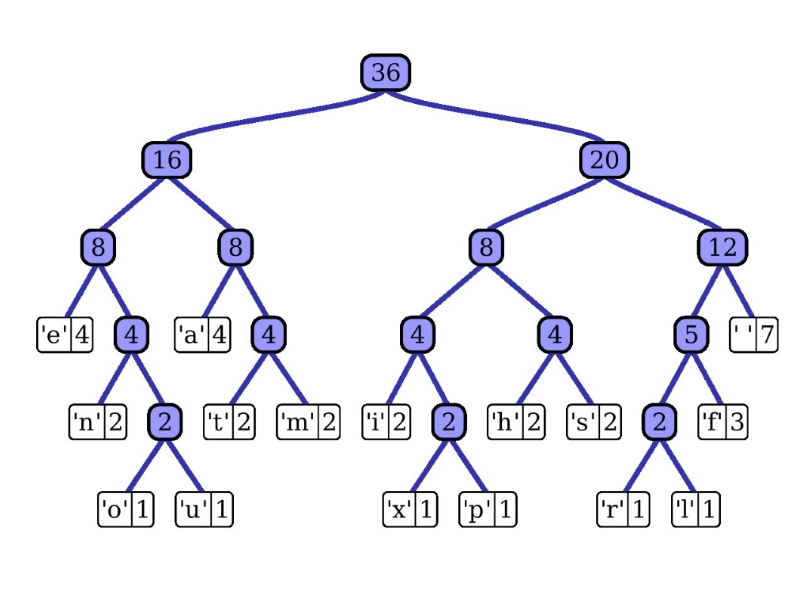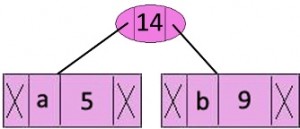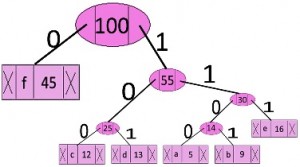الگوریتم کد گذاری هافمن (Huffman Coding) — به زبان ساده

در این مطلب، الگوریتم هافمن (Huffman Algorithm) مورد بررسی قرار خواهد گرفت. همچنین، پیادهسازی آن در زبانهای برنامهنویسی گوناگون شامل ++C و «جاوا» (Java) ارائه شده است. «کد هافمن» (Huffman Code) نوع خاصی از «کدهای پیشوندی» (Prefix Codes) بهینه است که اغلب برای فشردهسازی بیاتلاف اطلاعات مورد استفاده قرار میگیرد. فرایند پیدا کردن یا استفاده از این کد به وسیله کدگذاری هافمن (Huffman coding)، با بهرهگیری از الگوریتمی انجام میشود که توسط «دیوید آ هافمن» (David A. Huffman) توسعه داده شده است.
کدهای پیشوندی نوعی از کدها (توالی بیتها) هستند که در آنها کد اختصاص داده شده به یک کاراکتر پیشوند کد تخصیص داده شده به هیچ کاراکتر دیگری نیست. این، روشی است که کدگذاری هافمن با استفاده از آن اطمینان حاصل میکند که هیچ ابهامی هنگام رمزگشایی توالی بیتهای (جریان بیت) تولید شده وجود نخواهد داشت. در ادامه، برای درک بهتر موضوع، مثالی ارائه شده است. فرض میشود که چهار کاراکتر c ،b ،a و d موجود هستند و کدهای طول متغیر متناظر با آنها به ترتیب ۰۰، ۰۱، ۰ و ۱ است. این کدگذاری موجب ابهام میشود زیرا کد تخصیص یافته به c، پیشوند کدهای تخصیص یافته به a و b است. اگر جریان رشته فشرده شده ۰۰۰۱ است، خروجی که از حالت فشرده خارج شود امکان دارد cccd یا ccb یا acd یا ab باشد. دو بخش اصلی مهم در کدگذاری هافمن وجود دارد:
- ساخت درخت هافمن از کاراکترهای ورودی
- پیمایش درخت هافمن و تخصیص کد به کاراکترها
مراحل ساخت درخت هافمن
در اینجا، ورودی آرایهای از کاراکترهای یکتا با تکرار وقوع هر یک و خروجی یک «درخت هافمن» (درخت هافمن) است:
- یک گره برگ برای هر کاراکتر یکتا بساز و همچنین، «هرم کمینه» (Min Heap) از همه گرههای برگ را بساز (هرم کمینه به عنوان صف اولویت استفاده میشود. مقدار فیلد تکرار برای مقایسه دو گره در هرم کمینه مورد استفاده قرار میگیرد. به طور اولیه، کاراکتری با کمترین تکرار در ریشه است).
- دو گره با حداقل تکرار از هرم کمینه را استخراج کن.
- یک گره داخلی با فرکانسی برابر با مجموع تکرارهای دو گره را بساز. اولین گره استخراج شده را به عنوان فرزند سمت چپ و دیگر گره استخراج شده را به عنوان گره سمت راست قرار بده. این گره را به هرم کمینه اضافه کن.
- گامهای ۲ و ۳ را تا هنگامی که هرم تنها حاوی یک گره باشد تکرار کن. گره باقیمانده، گره ریشه و درخت کامل است.
در ادامه، برای درک بهتر موضوع، یک مثال بیان شده است.
character Frequency
a 5
b 9
c 12
d 13
e 16
f 45
گام ۱: یک هرم کمینه بساز که شامل ۶ گره است و هر گره، نشانگر ریشه درخت با یک گره یکتا است.
گام ۲: دو گره با کمترین تکرار را از درخت کمینه استخراج کن. گره داخلی جدید با تکرار ۱۴ = ۹ + ۵ را اضافه کن.

اکنون، هرم کمینه حاوی ۵ گره است که ۴ گره، هر یک با یک عنصر مجرد، ریشههای درختها هستند و یک گره هرم نیز ریشه درخت با ۳ عنصر است.
character Frequency
c 12
d 13
Internal Node 14
e 16
f 45
گام ۳: دو گره کمینه را از هرم استخراج کن. یک گره داخلی جدید با تکرار ۲۵ = ۱۲ + ۱۳ را اضافه کن.

اکنون، هرم کمینه حاوی ۴ گره است که دو گره هر یک با تنها یک عنصر ریشههای درختها هستند و دو گره هرم با بیش از یک گره، ریشه درخت هستند.
character Frequency
Internal Node 14
e 16
Internal Node 25
f 45
گام ۴: دو گره با کمترین تکرار را از هرم استخراج کن. یک گره داخلی جدید با تکرار ۳۰ = ۱۶ + ۱۴ اضافه کن.

اکنون، هرم اصلی حاوی ۳ گره است.
character Frequency
Internal Node 25
Internal Node 30
f 45
گام ۵: دو گره با تکرار کمتر را استخراج کن. یک گره داخلی با تکرار ۵۵ = ۳۰ + ۲۵ را اضافه کن.

اکنون، هرم اصلی حاوی دو گره است.
character Frequency
f 45
Internal Node 55
گام ۶: دو گره با کمترین تکرار را استخراج کن. یک گره داخلی جدید با تکرار ۱۰۰ = ۵۵ + ۴۵ را اضافه کن.

اکنون، هرم کمینه تنها حاوی یک گره است.
character Frequency Internal Node 100
به دلیل آنکه هرم تنها حاوی یک گره است، الگوریتم در این مرحله متوقف میشود.
چاپ کدها از درخت هافمن
پیمایش درخت ساخته شده، از ریشه آغاز میشود. برای این کار، باید از یک آرایه کمکی استفاده شود. در این راستا، هنگامی که به فرزند سمت چپ حرکت میشود، ۰ باید در آرایه نوشته شود و در حالیکه به سمت فرزند سمت راست حرکت میشود، ۱ را باید در آرایه نوشت.
آرایه را هنگامی که یک گره برگ مشاهده شد، چاپ کن.

کدها به صورت زیر هستند:
character code-word
f 0
c 100
d 101
a 1100
b 1101
e 111
در ادامه، پیادهسازی رویکرد بالا انجام شده است.
پیادهسازی الگوریتم هافمن در C
1// C program for Huffman Coding
2#include <stdio.h>
3#include <stdlib.h>
4
5// This constant can be avoided by explicitly
6// calculating height of Huffman Tree
7#define MAX_TREE_HT 100
8
9// A Huffman tree node
10struct MinHeapNode {
11
12 // One of the input characters
13 char data;
14
15 // Frequency of the character
16 unsigned freq;
17
18 // Left and right child of this node
19 struct MinHeapNode *left, *right;
20};
21
22// A Min Heap: Collection of
23// min-heap (or Huffman tree) nodes
24struct MinHeap {
25
26 // Current size of min heap
27 unsigned size;
28
29 // capacity of min heap
30 unsigned capacity;
31
32 // Array of minheap node pointers
33 struct MinHeapNode** array;
34};
35
36// A utility function allocate a new
37// min heap node with given character
38// and frequency of the character
39struct MinHeapNode* newNode(char data, unsigned freq)
40{
41 struct MinHeapNode* temp
42 = (struct MinHeapNode*)malloc
43(sizeof(struct MinHeapNode));
44
45 temp->left = temp->right = NULL;
46 temp->data = data;
47 temp->freq = freq;
48
49 return temp;
50}
51
52// A utility function to create
53// a min heap of given capacity
54struct MinHeap* createMinHeap(unsigned capacity)
55
56{
57
58 struct MinHeap* minHeap
59 = (struct MinHeap*)malloc(sizeof(struct MinHeap));
60
61 // current size is 0
62 minHeap->size = 0;
63
64 minHeap->capacity = capacity;
65
66 minHeap->array
67 = (struct MinHeapNode**)malloc(minHeap->
68capacity * sizeof(struct MinHeapNode*));
69 return minHeap;
70}
71
72// A utility function to
73// swap two min heap nodes
74void swapMinHeapNode(struct MinHeapNode** a,
75 struct MinHeapNode** b)
76
77{
78
79 struct MinHeapNode* t = *a;
80 *a = *b;
81 *b = t;
82}
83
84// The standard minHeapify function.
85void minHeapify(struct MinHeap* minHeap, int idx)
86
87{
88
89 int smallest = idx;
90 int left = 2 * idx + 1;
91 int right = 2 * idx + 2;
92
93 if (left < minHeap->size && minHeap->array[left]->
94freq < minHeap->array[smallest]->freq)
95 smallest = left;
96
97 if (right < minHeap->size && minHeap->array[right]->
98freq < minHeap->array[smallest]->freq)
99 smallest = right;
100
101 if (smallest != idx) {
102 swapMinHeapNode(&minHeap->array[smallest],
103 &minHeap->array[idx]);
104 minHeapify(minHeap, smallest);
105 }
106}
107
108// A utility function to check
109// if size of heap is 1 or not
110int isSizeOne(struct MinHeap* minHeap)
111{
112
113 return (minHeap->size == 1);
114}
115
116// A standard function to extract
117// minimum value node from heap
118struct MinHeapNode* extractMin(struct MinHeap* minHeap)
119
120{
121
122 struct MinHeapNode* temp = minHeap->array[0];
123 minHeap->array[0]
124 = minHeap->array[minHeap->size - 1];
125
126 --minHeap->size;
127 minHeapify(minHeap, 0);
128
129 return temp;
130}
131
132// A utility function to insert
133// a new node to Min Heap
134void insertMinHeap(struct MinHeap* minHeap,
135 struct MinHeapNode* minHeapNode)
136
137{
138
139 ++minHeap->size;
140 int i = minHeap->size - 1;
141
142 while (i && minHeapNode->freq < minHeap->array[(i - 1) / 2]->freq) {
143
144 minHeap->array[i] = minHeap->array[(i - 1) / 2];
145 i = (i - 1) / 2;
146 }
147
148 minHeap->array[i] = minHeapNode;
149}
150
151// A standard function to build min heap
152void buildMinHeap(struct MinHeap* minHeap)
153
154{
155
156 int n = minHeap->size - 1;
157 int i;
158
159 for (i = (n - 1) / 2; i >= 0; --i)
160 minHeapify(minHeap, i);
161}
162
163// A utility function to print an array of size n
164void printArr(int arr[], int n)
165{
166 int i;
167 for (i = 0; i < n; ++i)
168 printf("%d", arr[i]);
169
170 printf("\n");
171}
172
173// Utility function to check if this node is leaf
174int isLeaf(struct MinHeapNode* root)
175
176{
177
178 return !(root->left) && !(root->right);
179}
180
181// Creates a min heap of capacity
182// equal to size and inserts all character of
183// data[] in min heap. Initially size of
184// min heap is equal to capacity
185struct MinHeap* createAndBuildMinHeap(char data[], int freq[], int size)
186
187{
188
189 struct MinHeap* minHeap = createMinHeap(size);
190
191 for (int i = 0; i < size; ++i)
192 minHeap->array[i] = newNode(data[i], freq[i]);
193
194 minHeap->size = size;
195 buildMinHeap(minHeap);
196
197 return minHeap;
198}
199
200// The main function that builds Huffman tree
201struct MinHeapNode* buildHuffmanTree(char data[], int freq[], int size)
202
203{
204 struct MinHeapNode *left, *right, *top;
205
206 // Step 1: Create a min heap of capacity
207 // equal to size. Initially, there are
208 // modes equal to size.
209 struct MinHeap* minHeap = createAndBuildMinHeap(data, freq, size);
210
211 // Iterate while size of heap doesn't become 1
212 while (!isSizeOne(minHeap)) {
213
214 // Step 2: Extract the two minimum
215 // freq items from min heap
216 left = extractMin(minHeap);
217 right = extractMin(minHeap);
218
219 // Step 3: Create a new internal
220 // node with frequency equal to the
221 // sum of the two nodes frequencies.
222 // Make the two extracted node as
223 // left and right children of this new node.
224 // Add this node to the min heap
225 // '$' is a special value for internal nodes, not used
226 top = newNode('$', left->freq + right->freq);
227
228 top->left = left;
229 top->right = right;
230
231 insertMinHeap(minHeap, top);
232 }
233
234 // Step 4: The remaining node is the
235 // root node and the tree is complete.
236 return extractMin(minHeap);
237}
238
239// Prints huffman codes from the root of Huffman Tree.
240// It uses arr[] to store codes
241void printCodes(struct MinHeapNode* root, int arr[], int top)
242
243{
244
245 // Assign 0 to left edge and recur
246 if (root->left) {
247
248 arr[top] = 0;
249 printCodes(root->left, arr, top + 1);
250 }
251
252 // Assign 1 to right edge and recur
253 if (root->right) {
254
255 arr[top] = 1;
256 printCodes(root->right, arr, top + 1);
257 }
258
259 // If this is a leaf node, then
260 // it contains one of the input
261 // characters, print the character
262 // and its code from arr[]
263 if (isLeaf(root)) {
264
265 printf("%c: ", root->data);
266 printArr(arr, top);
267 }
268}
269
270// The main function that builds a
271// Huffman Tree and print codes by traversing
272// the built Huffman Tree
273void HuffmanCodes(char data[], int freq[], int size)
274
275{
276 // Construct Huffman Tree
277 struct MinHeapNode* root
278 = buildHuffmanTree(data, freq, size);
279
280 // Print Huffman codes using
281 // the Huffman tree built above
282 int arr[MAX_TREE_HT], top = 0;
283
284 printCodes(root, arr, top);
285}
286
287// Driver program to test above functions
288int main()
289{
290
291 char arr[] = { 'a', 'b', 'c', 'd', 'e', 'f' };
292 int freq[] = { 5, 9, 12, 13, 16, 45 };
293
294 int size = sizeof(arr) / sizeof(arr[0]);
295
296 HuffmanCodes(arr, freq, size);
297
298 return 0;
299}پیادهسازی الگوریتم هافمن در ++C
1// C++ program for Huffman Coding
2#include <iostream>
3#include <cstdlib>
4using namespace std;
5
6// This constant can be avoided by explicitly
7// calculating height of Huffman Tree
8#define MAX_TREE_HT 100
9
10// A Huffman tree node
11struct MinHeapNode {
12
13 // One of the input characters
14 char data;
15
16 // Frequency of the character
17 unsigned freq;
18
19 // Left and right child of this node
20 struct MinHeapNode *left, *right;
21};
22
23// A Min Heap: Collection of
24// min-heap (or Huffman tree) nodes
25struct MinHeap {
26
27 // Current size of min heap
28 unsigned size;
29
30 // capacity of min heap
31 unsigned capacity;
32
33 // Attay of minheap node pointers
34 struct MinHeapNode** array;
35};
36
37// A utility function allocate a new
38// min heap node with given character
39// and frequency of the character
40struct MinHeapNode* newNode(char data, unsigned freq)
41{
42 struct MinHeapNode* temp
43 = (struct MinHeapNode*)malloc
44(sizeof(struct MinHeapNode));
45
46 temp->left = temp->right = NULL;
47 temp->data = data;
48 temp->freq = freq;
49
50 return temp;
51}
52
53// A utility function to create
54// a min heap of given capacity
55struct MinHeap* createMinHeap(unsigned capacity)
56
57{
58
59 struct MinHeap* minHeap
60 = (struct MinHeap*)malloc(sizeof(struct MinHeap));
61
62 // current size is 0
63 minHeap->size = 0;
64
65 minHeap->capacity = capacity;
66
67 minHeap->array
68 = (struct MinHeapNode**)malloc(minHeap->
69capacity * sizeof(struct MinHeapNode*));
70 return minHeap;
71}
72
73// A utility function to
74// swap two min heap nodes
75void swapMinHeapNode(struct MinHeapNode** a,
76 struct MinHeapNode** b)
77
78{
79
80 struct MinHeapNode* t = *a;
81 *a = *b;
82 *b = t;
83}
84
85// The standard minHeapify function.
86void minHeapify(struct MinHeap* minHeap, int idx)
87
88{
89
90 int smallest = idx;
91 int left = 2 * idx + 1;
92 int right = 2 * idx + 2;
93
94 if (left < minHeap->size && minHeap->array[left]->
95freq < minHeap->array[smallest]->freq)
96 smallest = left;
97
98 if (right < minHeap->size && minHeap->array[right]->
99freq < minHeap->array[smallest]->freq)
100 smallest = right;
101
102 if (smallest != idx) {
103 swapMinHeapNode(&minHeap->array[smallest],
104 &minHeap->array[idx]);
105 minHeapify(minHeap, smallest);
106 }
107}
108
109// A utility function to check
110// if size of heap is 1 or not
111int isSizeOne(struct MinHeap* minHeap)
112{
113
114 return (minHeap->size == 1);
115}
116
117// A standard function to extract
118// minimum value node from heap
119struct MinHeapNode* extractMin(struct MinHeap* minHeap)
120
121{
122
123 struct MinHeapNode* temp = minHeap->array[0];
124 minHeap->array[0]
125 = minHeap->array[minHeap->size - 1];
126
127 --minHeap->size;
128 minHeapify(minHeap, 0);
129
130 return temp;
131}
132
133// A utility function to insert
134// a new node to Min Heap
135void insertMinHeap(struct MinHeap* minHeap,
136 struct MinHeapNode* minHeapNode)
137
138{
139
140 ++minHeap->size;
141 int i = minHeap->size - 1;
142
143 while (i && minHeapNode->freq < minHeap->array[(i - 1) / 2]->freq) {
144
145 minHeap->array[i] = minHeap->array[(i - 1) / 2];
146 i = (i - 1) / 2;
147 }
148
149 minHeap->array[i] = minHeapNode;
150}
151
152// A standard function to build min heap
153void buildMinHeap(struct MinHeap* minHeap)
154
155{
156
157 int n = minHeap->size - 1;
158 int i;
159
160 for (i = (n - 1) / 2; i >= 0; --i)
161 minHeapify(minHeap, i);
162}
163
164// A utility function to print an array of size n
165void printArr(int arr[], int n)
166{
167 int i;
168 for (i = 0; i < n; ++i)
169 cout<< arr[i];
170
171 cout<<"\n";
172}
173
174// Utility function to check if this node is leaf
175int isLeaf(struct MinHeapNode* root)
176
177{
178
179 return !(root->left) && !(root->right);
180}
181
182// Creates a min heap of capacity
183// equal to size and inserts all character of
184// data[] in min heap. Initially size of
185// min heap is equal to capacity
186struct MinHeap* createAndBuildMinHeap(char data[], int freq[], int size)
187
188{
189
190 struct MinHeap* minHeap = createMinHeap(size);
191
192 for (int i = 0; i < size; ++i)
193 minHeap->array[i] = newNode(data[i], freq[i]);
194
195 minHeap->size = size;
196 buildMinHeap(minHeap);
197
198 return minHeap;
199}
200
201// The main function that builds Huffman tree
202struct MinHeapNode* buildHuffmanTree(char data[], int freq[], int size)
203
204{
205 struct MinHeapNode *left, *right, *top;
206
207 // Step 1: Create a min heap of capacity
208 // equal to size. Initially, there are
209 // modes equal to size.
210 struct MinHeap* minHeap = createAndBuildMinHeap(data, freq, size);
211
212 // Iterate while size of heap doesn't become 1
213 while (!isSizeOne(minHeap)) {
214
215 // Step 2: Extract the two minimum
216 // freq items from min heap
217 left = extractMin(minHeap);
218 right = extractMin(minHeap);
219
220 // Step 3: Create a new internal
221 // node with frequency equal to the
222 // sum of the two nodes frequencies.
223 // Make the two extracted node as
224 // left and right children of this new node.
225 // Add this node to the min heap
226 // '$' is a special value for internal nodes, not used
227 top = newNode('$', left->freq + right->freq);
228
229 top->left = left;
230 top->right = right;
231
232 insertMinHeap(minHeap, top);
233 }
234
235 // Step 4: The remaining node is the
236 // root node and the tree is complete.
237 return extractMin(minHeap);
238}
239
240// Prints huffman codes from the root of Huffman Tree.
241// It uses arr[] to store codes
242void printCodes(struct MinHeapNode* root, int arr[], int top)
243
244{
245
246 // Assign 0 to left edge and recur
247 if (root->left) {
248
249 arr[top] = 0;
250 printCodes(root->left, arr, top + 1);
251 }
252
253 // Assign 1 to right edge and recur
254 if (root->right) {
255
256 arr[top] = 1;
257 printCodes(root->right, arr, top + 1);
258 }
259
260 // If this is a leaf node, then
261 // it contains one of the input
262 // characters, print the character
263 // and its code from arr[]
264 if (isLeaf(root)) {
265
266 cout<< root->data <<": ";
267 printArr(arr, top);
268 }
269}
270
271// The main function that builds a
272// Huffman Tree and print codes by traversing
273// the built Huffman Tree
274void HuffmanCodes(char data[], int freq[], int size)
275
276{
277 // Construct Huffman Tree
278 struct MinHeapNode* root
279 = buildHuffmanTree(data, freq, size);
280
281 // Print Huffman codes using
282 // the Huffman tree built above
283 int arr[MAX_TREE_HT], top = 0;
284
285 printCodes(root, arr, top);
286}
287
288// Driver program to test above functions
289int main()
290{
291
292 char arr[] = { 'a', 'b', 'c', 'd', 'e', 'f' };
293 int freq[] = { 5, 9, 12, 13, 16, 45 };
294
295 int size = sizeof(arr) / sizeof(arr[0]);
296
297 HuffmanCodes(arr, freq, size);
298
299 return 0;
300}پیادهسازی الگوریتم هافمن در ++C با استفاده از STL
1// C++ program for Huffman Coding
2#include <bits/stdc++.h>
3using namespace std;
4
5// A Huffman tree node
6struct MinHeapNode {
7
8 // One of the input characters
9 char data;
10
11 // Frequency of the character
12 unsigned freq;
13
14 // Left and right child
15 MinHeapNode *left, *right;
16
17 MinHeapNode(char data, unsigned freq)
18
19 {
20
21 left = right = NULL;
22 this->data = data;
23 this->freq = freq;
24 }
25};
26
27// For comparison of
28// two heap nodes (needed in min heap)
29struct compare {
30
31 bool operator()(MinHeapNode* l, MinHeapNode* r)
32
33 {
34 return (l->freq > r->freq);
35 }
36};
37
38// Prints huffman codes from
39// the root of Huffman Tree.
40void printCodes(struct MinHeapNode* root, string str)
41{
42
43 if (!root)
44 return;
45
46 if (root->data != '$')
47 cout << root->data << ": " << str << "\n";
48
49 printCodes(root->left, str + "0");
50 printCodes(root->right, str + "1");
51}
52
53// The main function that builds a Huffman Tree and
54// print codes by traversing the built Huffman Tree
55void HuffmanCodes(char data[], int freq[], int size)
56{
57 struct MinHeapNode *left, *right, *top;
58
59 // Create a min heap & inserts all characters of data[]
60 priority_queue<MinHeapNode*, vector<MinHeapNode*>, compare> minHeap;
61
62 for (int i = 0; i < size; ++i)
63 minHeap.push(new MinHeapNode(data[i], freq[i]));
64
65 // Iterate while size of heap doesn't become 1
66 while (minHeap.size() != 1) {
67
68 // Extract the two minimum
69 // freq items from min heap
70 left = minHeap.top();
71 minHeap.pop();
72
73 right = minHeap.top();
74 minHeap.pop();
75
76 // Create a new internal node with
77 // frequency equal to the sum of the
78 // two nodes frequencies. Make the
79 // two extracted node as left and right children
80 // of this new node. Add this node
81 // to the min heap '$' is a special value
82 // for internal nodes, not used
83 top = new MinHeapNode('$', left->freq + right->freq);
84
85 top->left = left;
86 top->right = right;
87
88 minHeap.push(top);
89 }
90
91 // Print Huffman codes using
92 // the Huffman tree built above
93 printCodes(minHeap.top(), "");
94}
95
96// Driver program to test above functions
97int main()
98{
99
100 char arr[] = { 'a', 'b', 'c', 'd', 'e', 'f' };
101 int freq[] = { 5, 9, 12, 13, 16, 45 };
102
103 int size = sizeof(arr) / sizeof(arr[0]);
104
105 HuffmanCodes(arr, freq, size);
106
107 return 0;
108}
109
110// This code is contributed by Aditya Goelپیادهسازی الگوریتم هافمن در جاوا
1edit
2play_arrow
3
4brightness_4
5import java.util.PriorityQueue;
6import java.util.Scanner;
7import java.util.Comparator;
8
9// node class is the basic structure
10// of each node present in the Huffman - tree.
11class HuffmanNode {
12
13 int data;
14 char c;
15
16 HuffmanNode left;
17 HuffmanNode right;
18}
19
20// comparator class helps to compare the node
21// on the basis of one of its attribute.
22// Here we will be compared
23// on the basis of data values of the nodes.
24class MyComparator implements Comparator<HuffmanNode> {
25 public int compare(HuffmanNode x, HuffmanNode y)
26 {
27
28 return x.data - y.data;
29 }
30}
31
32public class Huffman {
33
34 // recursive function to print the
35 // huffman-code through the tree traversal.
36 // Here s is the huffman - code generated.
37 public static void printCode(HuffmanNode root, String s)
38 {
39
40 // base case; if the left and right are null
41 // then its a leaf node and we print
42 // the code s generated by traversing the tree.
43 if (root.left
44 == null
45 && root.right
46 == null
47 && Character.isLetter(root.c)) {
48
49 // c is the character in the node
50 System.out.println(root.c + ":" + s);
51
52 return;
53 }
54
55 // if we go to left then add "0" to the code.
56 // if we go to the right add"1" to the code.
57
58 // recursive calls for left and
59 // right sub-tree of the generated tree.
60 printCode(root.left, s + "0");
61 printCode(root.right, s + "1");
62 }
63
64 // main function
65 public static void main(String[] args)
66 {
67
68 Scanner s = new Scanner(System.in);
69
70 // number of characters.
71 int n = 6;
72 char[] charArray = { 'a', 'b', 'c', 'd', 'e', 'f' };
73 int[] charfreq = { 5, 9, 12, 13, 16, 45 };
74
75 // creating a priority queue q.
76 // makes a min-priority queue(min-heap).
77 PriorityQueue<HuffmanNode> q
78 = new PriorityQueue<HuffmanNode>(n, new MyComparator());
79
80 for (int i = 0; i < n; i++) {
81
82 // creating a Huffman node object
83 // and add it to the priority queue.
84 HuffmanNode hn = new HuffmanNode();
85
86 hn.c = charArray[i];
87 hn.data = charfreq[i];
88
89 hn.left = null;
90 hn.right = null;
91
92 // add functions adds
93 // the huffman node to the queue.
94 q.add(hn);
95 }
96
97 // create a root node
98 HuffmanNode root = null;
99
100 // Here we will extract the two minimum value
101 // from the heap each time until
102 // its size reduces to 1, extract until
103 // all the nodes are extracted.
104 while (q.size() > 1) {
105
106 // first min extract.
107 HuffmanNode x = q.peek();
108 q.poll();
109
110 // second min extarct.
111 HuffmanNode y = q.peek();
112 q.poll();
113
114 // new node f which is equal
115 HuffmanNode f = new HuffmanNode();
116
117 // to the sum of the frequency of the two nodes
118 // assigning values to the f node.
119 f.data = x.data + y.data;
120 f.c = '-';
121
122 // first extracted node as left child.
123 f.left = x;
124
125 // second extracted node as the right child.
126 f.right = y;
127
128 // marking the f node as the root node.
129 root = f;
130
131 // add this node to the priority-queue.
132 q.add(f);
133 }
134
135 // print the codes by traversing the tree
136 printCode(root, "");
137 }
138}
139
140// This code is contributed by Kunwar Desh Deepak Singhخروجی قطعه کدهای بالا به صورت زیر است.
f: 0 c: 100 d: 101 a: 1100 b: 1101 e: 111
پیچیدگی زمانی روش ارائه شده از درجه (O(nlogn است که در آن، n تعداد کاراکترهای یکتا محسوب میشود. اگر n گره وجود داشته باشد، ()extractMin به تعداد $$2*(n – 1)$$ مرتبه فراخوانی میشود.
()extractMin از درجه (O(logn است، زیرا ()minHeapify را فراخوانی میکند. بنابراین، پیچیدگی کلی از درجه (O(nlogn خواهد بود. اگر آرایه ورودی مرتب شده باشد، الگوریتم دارای پیچیدگی زمانی خطی میشود.
اگر نوشته بالا برای شما مفید بوده است، آموزشهای زیر نیز به شما پیشنهاد میشوند:
- مجموعه آموزشهای برنامه نویسی
- آموزش ساختمان دادهها
- مجموعه آموزشهای ساختمان داده و طراحی الگوریتم
- رنگآمیزی گراف به روش حریصانه — به زبان ساده
- الگوریتم دایجسترا (Dijkstra) — از صفر تا صد
- الگوریتم پریم — به زبان ساده
- برنامه تجزیه عدد به عوامل اول آن — به زبان ساده
^^











سلام. ممنون از زحمتی که برای ترجمه کشیدید؛ ولی اگر از منبعی استفاده میکنید، خوبه که اون رو هم ذکر کنید.
با سلام؛
منبع تمامی مطالب مجله فرادرس اگر ترجمه باشند در انتهای مطلب و پیش از نام نویسنده آورده شدهاند.
با تشکر از همراهی شما با مجله فرادرس
با تشکر از شما . نکته ی حائز اهمین این که کد C رو اگر صرفا به جای printf از cout استفاده کنن تبدیل به کد C++ نمی شه . و تقاوت های ماهوی این دو کد بسیار بیشتر از این حرفاست .ممنون از این که این کد رو در سایت قرار دادید
سلام… آیا الگوریتم کدگشایی هم جزو این برنامه هست؟؟؟
سلام
می خواستم بدونم این کد های بالا برای کد گذاری فایل های باینری می باشد؟؟ با الگوریتم هافمن
اگه نیستش لطفا بگید چه تغییراتی باید تو کد بدم؟
با سلام؛
از همراهی شما با مجله فرادرس سپاسگزارم. قطعه کدهای ارائه شده در این مطلب، پیادهسازی الگوریتم کدگذاری هافمن هستند و در آن، به عنوان نمونه، یک آرایه از کاراکترها به عنوان ورودی به برنامه داده شده است تا کاربر بتواند با اجرای کد، نمونه خروجی را مشاهده کند. برای کدگذاری هافمن محتوای یک فایل، کافی است این کد را به گونهای تغییر دهید که فایل را به عنوان ورودی دریافت، محتوای آن را کدگذاری و خروجی را در همان فایل یا فایل دیگری، بازگرداند.